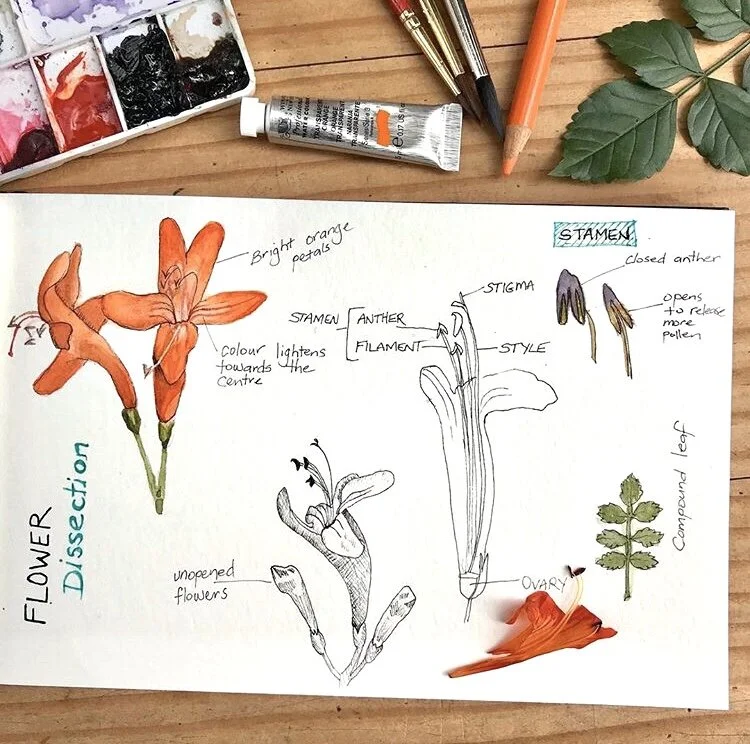10 things to include on your journal page
There are many different ways to keep a nature journal. In fact, your nature journal will be as unique as you are! If you like art, your pages may be focused primarily on sketches. If you prefer writing, you may find your pages are filled with poetic ramblings in response to nature. Still others will fill their pages with scientific facts and observations.
This article will detail 10 elements that are commonly included on a nature journal page and a few reasons why you might like to incorporate them. You can include some or all of them to build a journal page that reflects your personal taste and style.
1. Metadata
Metadata is a little collection of data that is usually recorded somewhere at the top of the page. This can include the date, time, location and weather. If you want to go further you might also add temperature, wind direction, moon phase or time of sunrise and sunset. This information can be presented as numbers, words or a series of small icons. For example, a little cloud with a sun peeping over the top could be used to record the weather on a partially cloudy day. Develop your own set of icons for a short-hand way of recording your metadata.
The environment changes in response to time of day, weather and season. Having a record of this information gives you clues about nature and can help deepen your understanding of what you observe.
2. Title
Giving your page a title can tie everything together. You might like to leave a space for your title and add it once you have finished the rest of your page. A title can be a unifying element and gives an overview of what the page is about. For ideas on the style of lettering you might like to use, try an online search for “Hand lettering alphabet” to discover a range of styles.
3. Sketches
Sketches are a wonderful way of illustrating what you see in nature. They can be graphite or ink sketches or you can add colour with colour pencils or watercolour. It is important not to stress too much about trying to make “art” in your journal. Just try to observe closely and record what you see. Your sketching will improve the more you practice.
4. Labels
John Muir Laws likes to say that labels turn a sketch into a diagram! Add notes on the texture, shape and size of your subject as well as anything else of interest. It will help you remember what you saw, and these details can be used to identify something from a field guide at a later time.
Labels turn a sketch into a diagram!
5. Measurements and counts
Measurements and quantification can add another layer to your journal. Use a ruler or scale to show the actual size of a specimen or use counts and measurements to create informative charts. This is a great way to compare sets of data collected in different locations or at different times.
6. Questions
Questions are at the heart of scientific inquiry and are extremely useful in your nature journal. Questions open and expand our minds and allow us to think about things in new ways. Every new discovery starts with a great question!
7. Boxes
Sometimes adding boxes can bring the page design together in an attractive way. You can create a box using a single line or a block of colour. A page border is another kind of box which can unify a design. One trick is to let the sketch break out of the boundary, in several places. This adds a pleasing dynamism to the layout.
Let the drawing break from the boundaries of the box in places.
8. Mini landscape
A mini landscape is a great way to add context to your journal entry. If you find yourself always sketching leaves, flowers and other found objects, including a mini landscape can help capture more information about the environment you are exploring. Keep your landscapes small so that they’re more manageable and less intimidating. A simple sketch will add so much to your page.
Including a mini landscape adds context
9. Colour swatches
Colour swatches can be a lovely addition to a nature journal page. If you are short on time while in the field, you can jot down some notes about colours you saw to remind you later. Colour notes are a lot of fun! Once you start closely observing colours in nature you will notice that colour variation is almost infinite.
Adding colour swatches can be a lot of fun
10. Writings
You can use writing in different ways in your journal. You can include scientific notes, species lists or observation on animal behaviour. You can write about how you felt and what was in your mind and heart while outdoors. You can also include poetry or long form prose about nature and your connection to the natural world. Putting thoughts into words will help you clarify personal reflections and understand exactly what you felt and observed.
There are many different elements you can include while journaling. Try mixing and matching several different elements to enliven your designs and bring your journal pages to life!
You can find Bethan’s work on her website: www.journalingwithnature.com; as well as on Instagram @journalingwithnature and Facebook - Journaling With Nature.








